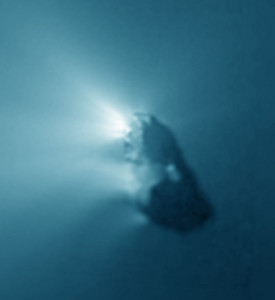Donald V. Etz
Halley’s Comet
Halley’s Comet is named after Edmond Halley (1656-1742) who correctly  predicted its periodicity and that it would return after his death in 1759. Bill Arnett has advised that “The average period of Halley’s orbit is 76 years but you cannot calculate the dates of its reappearances by simply subtracting multiples of 76 years from 1986. The gravitational pull of the major planets alters the orbital period from revolution to revolution. Nongravitational effects (such as the reaction from gasses boiled off during its passage near the Sun) also play an important, but smaller, role in altering the orbit. Between the years 239 BC and 1986 AD the orbital period has varied from 76.0 years (in 1986) to 79.3 years (in 451 and 1066).“(q)
predicted its periodicity and that it would return after his death in 1759. Bill Arnett has advised that “The average period of Halley’s orbit is 76 years but you cannot calculate the dates of its reappearances by simply subtracting multiples of 76 years from 1986. The gravitational pull of the major planets alters the orbital period from revolution to revolution. Nongravitational effects (such as the reaction from gasses boiled off during its passage near the Sun) also play an important, but smaller, role in altering the orbit. Between the years 239 BC and 1986 AD the orbital period has varied from 76.0 years (in 1986) to 79.3 years (in 451 and 1066).“(q)
In 1694 Halley proposed(f) that Noah’s Flood had been caused by a cometary impact, a suggestion for which he was censured by the Royal Society. However, he was rather off the mark when he was the first to propose a ‘hollow Earth’ in 1692(c).
Although the comet’s average orbital period is 76 years, it has been as high as 79.3 years. The nucleus of Halley’s Comet is approximately 5x5x10 miles but has a very low density. The earliest observation of the comet was noted in 240 BC by the Chinese, although there is now a suggestion of 466 BC being the earliest reference in ancient Greek records(e). It has also been famously recorded on the Bayeux Tapestry, mentioned in the Talmud and frequently associated with the Star of Bethlehem(h).
A more recent suggestion has been that a fragment of HC hit the Earth in 536 AD lowering temperatures globally causing drought, famine and disease(g).
Polish Professor Kamienski considered the biblical mention of ‘an angel with a sword’ (1Chron 21.16) to be a reference to Halley’s appearance around 1010 BC. However, Kamienski dated another close encounter with Halley’s Comet, which led to the destruction of Atlantis, to circa 9550 BC. In a similar fashion, the historian Donald V. Etz in 1986(b) argued that Isaiah 14.12-15 was possibly inspired by the appearance of the same comet.
 Halley’s comet was considered a harbinger of doom as its appearance seemed to eerily coincide with various disasters, both natural and military.
Halley’s comet was considered a harbinger of doom as its appearance seemed to eerily coincide with various disasters, both natural and military.
In 1956, Kamienski then entered the contentious matter of the date of the Trojan War, which he proposed had ended circa 1165 BC and suggested that it may have coincided with the appearance of Halley’s Comet!(o)
Halley’s Comet, in fact, comets generally, were considered to be harbingers of doom, as their appearance seemed to eerily coincide with various disasters, both natural and military.
In 1456, Pope Calixtus III excommunicated the comet as an agent of Satan. This appears to have been theologically unsound as the comet was never a member of the Church in the first place. Amazingly, comets have continued to reappear, obviously concurrent with a least one of the daily earthbound calamities that is our lot.
The French astronomer Nicolas Camille Flammarion predicted that the appearance of Halley’s Comet in 1910 would fill the earth’s atmosphere with toxic gas and kill all life on earth! Obviously, nothing catastrophic happened then nor on its next visit in 1986.
Another suggested date for Halley’s Comet leading to the demise of Atlantis is 1628 BC put forward by David Wiseman, a Bible teacher(d).
Jean Silvain Bailly was the first to compute the orbit of the comet and coincidentally also wrote on the subject of Atlantis at the end of the 18th century.
Col. Braghine theorised that Atlantis was destroyed as a result of a close encounter of the Earth with Halley’s Comet and similarly the Polish Professor Kamienski suggested that a large chunk of Halley’s Comet fell into the Gulf of Mexico in 9542 BC. Kamienski has also written very technical paper(a) on the 2320 BC appearance of the comet. The American astronomer Jack Hills, an asteroid specialist at the Los Alamos National Laboratory holds similar views to Kamienski.
>The earliest claimed sighting of Halley’s Comet appears to have come from Dr Manish Pandit, who has proposed that it was seen as early as 3067 BC(p).<
Halley’s Comet has also been blamed for the disappearance of the Pannonian Lake, another proposed Atlantis location.
Jürgen Spanuth thought that Phaëton was a fragment of Halley’s Comet. Two other followers of Spanuth, Günter Bischoff and Walter Stender have written extensive papers, in German, on a meteorite impact with Northern Europe around 1220 BC, which they also identified as Phaëton(j)(n). The same interpretation has been applied specifically to Lake Chiemgau in S.E. Bavaria and is expanded on in papers by Barbara Rappenglück among many others(k)(l)(m).
In a 2018 paper(i), Charles A Rogers associates Phaëton with Halley’s Comet, dating the close encounter to 1404 BC. He goes further, linking the ‘pillar of light’ in Exodus with both Halley’s Comet and the eruption of Thera. He then proceeds to connect this event(s) with the destruction of Atlantis on the Gulf of Gabes at the mouth of the River Triton!
Clube & Napier in The Cosmic Winter [290]suggested that the Biblical Exodus story contains the earliest reference to Halley’s Comet. The controversial Jeffrey Goodman also links a number of Biblical events with cometary encounters in The Comets of God [1687].
For trivia lovers, I note that both the birth (1835) and death (1910) of the writer Mark Twain coincided with appearances of Halley’s Comet!
(a) http://articles.adsabs.harvard.edu//full/1956AcA…..6….3K/0000003.000.html
(b) https://www.jstor.org/pss/1518410
(c) https://dioi.org/kn/halleyhollow.htm
(d) See Archive 3339
(e) https://baringtheaegis.blogspot.ie/2014/07/a-recorded-ancient-hellenic-sighting-of.html
(f) https://www.jasoncolavito.com/halley-on-noahs-comet.html
(g) https://www.q-mag.org/fragment-of-halleys-comet-hit-earth-in-536-a-d-causing-drought-and-famine.html
(h) https://ufosightingshotspot.blogspot.ie/2017/05/earth-entering-debris-field-from.html
(i) https://www.academia.edu/36855091/Atlantis_Once_Lost_Now_Found
(j) https://www.efodon.de/html/archiv/vorgeschichte/bischoff/2003-SY5%20bischoff_phaeton.pdf
(k) http://impact-structures.com/news/Stoettham_c.pdf
(m) https://guginew.blogspot.ie/2011/09/fall-of-phaethon-greco-roman-geomyth.html
(o) Atlantis, Volume 10 No. 3, March 1957
